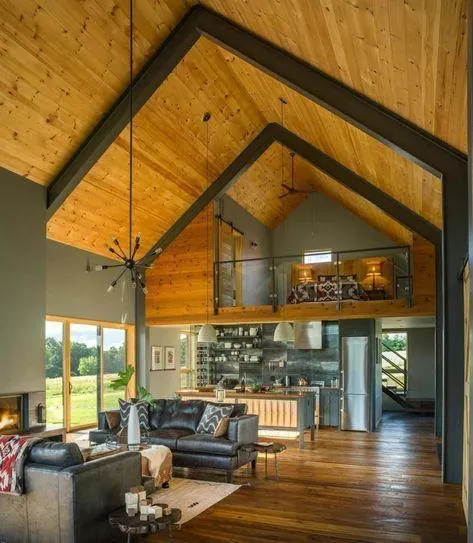You, like many others, maybe in the middle of the “steel vs wood building cost” dilemma. It strikes those who are trying to decide between building a traditional all-steel barndominium and one that is made up largely of wooden components. But which will be most cost-effective?

Maybe the decision will be a little easier if we point out some key differences between the two, particularly when it comes to costs.
Page Contents
Steel vs wood building cost, short-term
- Short term, builders say that it takes twice as long to erect an all–wood structure. It’s much easier to put up a four-sided metal barndo with a clear span continuous metal roof.
- In addition, a wood-framed barndo will almost certainly require skilled carpenters to erect.
- But metal buildings– especially those that come prepackaged in a “kit” — often just need a handful of workers with fundamental skills and proper instruction to be put together successfully.
- Naturally, this means higher building costs for wooden barndos because of additional labor hours and a longer construction timetable.
- But, builders add, steel has a much higher initial purchase cost.
- “The average cost of steel framing for a house is between $9.50 and $11 per square foot for materials. Lumber costs fluctuate, but the cost of wood framing a house averages between $1 and $5 per square foot,” according to kompareit.com
- So, when everything is taken into consideration, unless there’s a shortage, wood and other related materials — not steel — will always be the more inexpensive construction material option in the short term.
Well, what about long-term?
- Long term — among other things — wooden structures need a fresh coat of paint at least once every 5 to 10 years.
- By contrast, steel barndominiums — with metal frames and building components — often have both panel and roof warranties that last for as long as 50 years.
Here are a few more key differences:
Steel is far more durable than wood, giving it a much longer lifespan. This means that wood barndominium owners will have to spend more money to carry out repairs or renovations at some point. This is the result of pests, wood rot, or just general wear and tear.
There are also higher maintenance costs associated with wood barndominiums.
This includes applying paint every 5 to 10 years, repairing any roof damage, and fixing up wood rot or warping.
Steel is impervious to cracking, warping, pests and mold, making for very low maintenance costs.
And, possibly the most long-term building impact pertaining to this debate is the recyclability of a true barndominium. Steel barndos can be almost 100 percent recycled even after a century. Wood barndos, however, leave very little in the way of salvage opportunities.
A summary of the whole “steel vs wood” question
If you’ve got your sights set on a steel barndo, then the initial cost of materials is what will hurt your wallet the most.
As a rule of thumb. in the construction industry, wood and other related basic materials will always be cheaper. Unless you can’ source it locally.
In fact, if we focus on just the initial cost of materials alone, steel is way more expensive than wood, stone, brick, and concrete.
In some regions, the steel type or volume required to construct your barndominium might not even be available locally — or even regionally. This further adds to transportation costs stemming from long distance shipping.
Wood, on the other hand, is almost always available locally and remains the most affordable construction material of all.
Labor costs and the construction timetable

“Time is money,” they say. And that has never been truer than when used to describe the construction industry. Labor is usually the largest expense when building any structure.
So the more you can cut down on working hours, the less costly it will be for you.
Wood barndominiums — especially those done in the “post and beam” style — require incredibly skilled workers. Especially if it’s a custom-built barndo. Bur even a kit from a post and beam supplier would prove enormously challenging to an inexperienced crew.
For those who might not understand the finer distinctions we’re trying to make here about steel vs wood building cost, you need professional carpenters and woodworkers for the framing of any wooden structure. Cutting the lumber to size, drilling in holes for wiring and many other routine tasks associated with “stick built” construction can be challenging for non=pros.
With steel barndominiums, though, you can get a lot of the framing and side panels done long before a kit even gets delivered to your construction site.
In fact, there are manufacturers that do nothing but sell entire barndominiums in pre-made kits that only require assembly.
Here’s a link to another article on this site that includes a list of kit builders.
Let’s talk durability and longevity
Wood is incredibly tough. In the right hands, you could get an entire doomsday bunker built out of the stuff.
So if — instead of steel — you’ve got your sights set on a wood barndominium, there’s nothing major to worry about. Even after all this talk hinting that metal is a better building material long term.
But, to be honest, if we’re looking ahead, the structural strength and integrity of wood leaves a lot to be desired. Great short-term savings could turn out to be serious repair expenses in the long run.
The main problem with wood is its susceptibility to… well, pretty much everything on the planet.
From burrowing insects to nightmare pests like termites, there’s a lot of wildlife waiting to call your new barndo home.
And, wood tends to absorb moisture, contracting and expanding as it dries out. If you live in a high humidity zone, there might be a few issues with the framing. Eventually reaching the drywall and attached coverings.
Wood availability — is it really so easy to find?

Another fact that could prove detrimental to your preference for an all-wood barndominium in the long run has to do with the typical inconsistencies associated with sourcing wood.
Obviously, the timber used to build your entire barndo won’t come from the same tree, or even the same region in some cases.
Different types of wood from different regions tend to vary remarkably in both quality and consistency. This disparity can cause problems. You can imagine the effect after about 10 to 15 years of exposure to the elements.
As a solution, manufacturers have taken measures. They try and make sure that barndominiums made of wood are both weather and pest resistant.
But the fact remains that steel barndominiums are 100 percent impervious to pests, and resistant to fire. And, they can withstand natural phenomenon like high winds or seismic activity.
They may be prone to a bit of condensation, but that’s nothing that high quality insulation can’t solve. Like spraying in a six-inch thick layer of closed cell foam insulation.
Energy efficiency, heating expenses and more
Here’s one area in which wood has steel beat by a mile — energy efficiency. Especially heat transfer.
Wood acts as its own first line of insulation. But steel actively transfers both heat and cold to the entire structure of your barndominium. Without proper insulation, people in steel barndominiums could run much higher costs in terms of heating bills.
Likewise, wood’s acoustic properties make it the best material for minimizing noise and vibrations in living and work spaces.
Instead of amplifying or reflecting sound like metal does, wood actually absorbs noise and minimizes echoes in the house.
Naturally, this added noise reduction makes wood more attractive for constructing commercial spaces.
Here’s a caveat
And, to this point, we add a caveat. If you do go with steel, there might be some costs around soundproofing and noise insulation. Sometimes the sound of rain on a metal roof can be soothing, but it also can be distracting.
However, all of these issues can be solved by simply installing proper insulation — for both wood and steel barndos.
But if we’re really thinking about the distant future, wood’s energy efficiency seems a bit short-lived.
The fact that steel can be completely recycled again and again not only reduces its carbon footprint, it also increases the total life cycle efficiency as a whole.
So even after about 100 years, a large percentage of the steel barndo could still be salvaged and recycled, while wood will have to be used for fire or taken to the landfill.
Steel vs wood building costs: the verdict
Now that you’ve seen which material will make the most sense long term, making that final decision should be much easier about steel vs wood building cost.
Wood will definitely save you money initially. But that’s about all the savings you can expect from your wood barndominium. From there, it’s all downhill in terms of
- the extended construction timetable,
- labor costs, and
- maintenance
Steel, on the other hand, is the complete opposite.
While it will definitely cost you more to acquire the materials, your metal barndo will pay for itself in the long run.
Building it is faster, easier, and you can be sure it will last longer than wood. And, the low maintenance costs also make it worth the initial price.
But our final advice? Let your budget, intended purpose and personal preferences guide you when building your barndominium. Do that, and you’ll find your happiness is worth more than a few hundred bucks saved here and there.
